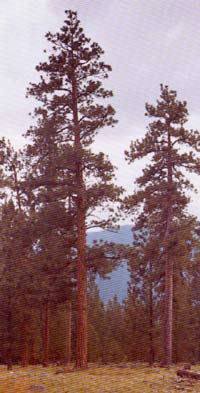Plant Data
Sheet: Western White Pine (Pinus monticola)

Range
Western white pine occurs from coastal and mountainous areas
of
Climate,
elevation
The distribution of western white pine is limited at low
elevations by lack of moisture, and at high elevation by low temperatures. Western
white pine occurs from sea level to subalpine areas (3).
Local
occurrence
Western white pine was once abundant in the
Habitat
preferences
Western white pine is found from moist valleys to fairly
open and dry slopes (3,5). It prefers well drained soils, although the
species has been found in bogs (2).
Plant
strategy type/successional stage
Western white pine is a seral to
climax species.
Associated
species
Due to its large range and diverse growing conditions,
Western white pine has many associated species.
These include grand fir, subalpine fir, lodgepole pine, ponderosa pine, Jeffrey pines, western
larch, western redcedar, western and mountain
hemlock, Douglas-fir, and Engelmann and
May be collected as: (seed, layered, divisions, etc.)
Western white pine is typically propagated by seed. For large-scale forestry applications, it is
also propagated via tissue culture or by grafting white pine onto the rootstock
of related species. Plants under three meters in height can be salvaged with success as
well (2).
Collection
restrictions or guidelines
Pollination occurs early in the first season after cone
formation. The egg is fertilized early in the second year and the seed
is formed during the growing season of the second year. It matures during this
period (late summer and fall of the second year). The cones release their seed
immediately upon maturity and should be collected promptly to prevent seed loss
(1). Collect seed in
June-August from cones that are yellowish to dark brown in color (2).
Seed should be collected from blister rust resistant individuals if possible.
Seed
germination (needs dormancy breaking?)
Fresh seed has been reported to germinate without cold
stratification. In most cases, stored
seed will require stratification. A two to three month stratification at 45F should provide
uniform germination. Soaking the seed
for 1 to 2 days in aerated water is also recommended for many pine species (1).
Seed
life
As a general rule, pine seeds can be stored for long periods of time (1).
Recommended
seed storage conditions
Seed life is extended when stored at a seed moisture
content of around 10% (1).
Propagation
recommendations
For a general propagationist,
propagation by seed is the most practical method. Tissue culture is also an option if resources
are available.
Soil
or medium requirements
No
information on soil requirements was found.
Installation
form
Installation
of seedlings is common.
Recommended
planting density
For
restoration activities, trees should be spaced from 6-15 feet on center,
depending on the desired density (4).
Care
requirements after installed
No
specific information on post-installation care was found.
Normal
rate of growth or spread; lifespan
Western white pine is a medium sized, long lived tree. It typically reaches heights of up to 40 m,
although much taller individuals can be found (3).
Sources
cited
(1) Couvillon, G. http://www.uga.edu/plantprop/index.html.
Retrieved April 22, 2003.
(2) Leigh, M.
(1999). Grow Your Own Native
Landscape: A guide to identification,
propagation, and landscaping with western
(3) Pojar, J. & MacKinnon, A
(eds.) (1994). Plants of the
(4) Sound
Native Plants. http://www.soundnativeplants.com.
Retrieved
(5) Tree
Guide. http://www.treeguide.com. Retrieved
Data
compiled by (student name and date)
Sarah Baker (